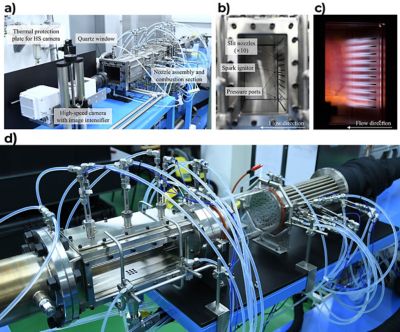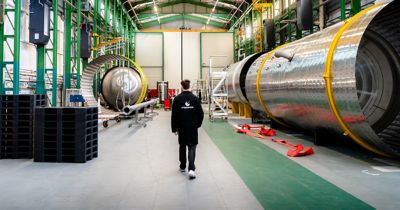-
United States -
United Kingdom -
India -
France -
Deutschland -
Italia -
日本 -
대한민국 -
中国 -
台灣
-
Ansys stellt Studierenden auf dem Weg zum Erfolg die Simulationssoftware kostenlos zur Verfügung.
-
Ansys stellt Studierenden auf dem Weg zum Erfolg die Simulationssoftware kostenlos zur Verfügung.
-
Ansys stellt Studierenden auf dem Weg zum Erfolg die Simulationssoftware kostenlos zur Verfügung.
-
Kontakt -
Karriere -
Studierende und Akademiker*innen -
Für die Vereinigten Staaten und Kanada
+1 844,462 6797

Korea Advanced Institute of Science & Technology (KAIST), Daejeon, is collaborating with Ansys for predicting flame structure for hydrogen-methane blended flames using large eddy simulations.
Hydrogen has gained the front seat as a fuel for carbon neutrality. The absence of carbon emission at the point of utilization makes it attractive for net-zero initiatives. Hydrogen fuel possesses qualities like higher flame speed (8x higher), lower ignition energy requirements (15x lower), and wider flammability limit (4% to 70%) compared to typical hydrocarbons1. These characteristics of hydrogen provide opportunities as well as challenges in designing energy conversion systems based on hydrogen and hydrogen-blended fuels.
The characteristics of hydrogen enable better efficiency and combustion stability. However, the higher flame speed and wider flammability limit of hydrogen pose key challenges concerning flashback and other safety-related issues. The higher flame temperature in hydrogen flames poses challenges for nitrogen oxides (NOx) and metal protection. A strong differential diffusion of hydrogen due to its lower Lewis number (the ratio of thermal diffusivity to mass diffusivity), is a major concern for combustion instabilities. The differential diffusion leads to variations of the local equivalence ratio and, hence, reaction rates along the flame front. Therefore, the adoption of hydrogen as a cleaner fuel at a large scale depends on how quickly the issues related to flashback, NOx emission, and combustion instabilities are addressed.
Several research groups are investigating ways to mitigate these challenges using laboratory tests and simulations. Korea Advanced Institute of Science & Technology (KAIST), Daejeon, and Ansys are developing computational fluid dynamics (CFD) methods and best practices for predicting flame structure for hydrogen-methane blended flames using large eddy simulations (LES).
Research Conducted at KAIST Combustion Dynamics and Diagnostics Laboratory
KAIST CDDL is investigating low- and high-frequency combustion instabilities in heavy-duty gas turbine combustors, aircraft engine afterburners, and bipropellant liquid rocket engines. Its current research efforts focus on:
- The triggering of high-frequency combustion instabilities, as well as related intricate modal dynamics and mechanistic details of the multikilohertz transverse thermoacoustic fluctuations.
- Laser diagnostic measurements and numerical simulations of ammonia/hydrogen-based carbon-free gas turbine combustion.
- Detailed characterizations of topological features stemming from the self-excited dynamics of the transverse reacting jet in advanced axial fuel staged combustion systems.

(a) Experimental test rig, (b) combustion chamber view from quartz window, (c) flames, (d) zoomed view of the test rig
Ansys Simulation Methodologies for Hydrogen and Hydrogen-blended Fuel
Most of the previous combustion models and best practices evolved over the years for hydrocarbon fuels and are validated for the rich sources of experimental data. These models and best practices need to be studied and validated for hydrogen and hydrogen-blended fuels. The Ansys CFD team has been evaluating different combustion modeling methodologies. They are developing new models and best practices to simulate reacting flow systems based on hydrogen and hydrogen-blended fuels. Some of the studies have already been published in open literature in the last couple of years. Interested readers can refer to blogs and papers mentioned in the references section below.

Schematic of KAIST experimental test rig
KAIST and Ansys Collaborate to Predict Flame Characteristics
KAIST research group, led by professor Kim, is working with Ansys to use high-quality hydrogen and hydrogen-blended test data generated at the KAIST Combustion Dynamics and Diagnostics Laboratory to develop CFD modeling methodologies to predict the flame characteristics and validate that against the test data. This will enable the research community to get more details about the combustion systems and design more efficient systems for the future. Derived models and best practices can be easily deployed to complex industrial cases from both experimental tests as well as simulation points of view.
Some of the sample results obtained from this collaboration are shown below. More details on the approach used and the validation work will be published soon.
By collaborating with leading researchers, Ansys is helping to advance the state of the art in hydrogen fuels. For more information, visit our hydrogen value chain solutions page. If you are visiting ASME Turbo Expo 2024 June 24-28, please stop by the Ansys booth #305 to learn more about our solution on hydrogen simulations.

Qualitative flame shape prediction and comparison with the test data
References
- U.J Pfahl, M.C Ross, J.E Shepherd, K.O Pasamehmetoglu, and C Unal, “Flammability limits, ignition energy, and flame speeds in H2–CH4–NH3–N2O–O2–N2 mixtures”, Combust Flame, 123, (1–2), 2000, pp. 140-158, https://doi.org/10.1016/S0010-2180(00)00152-8.
- S. Shrivastava and I Verma, “Accelerate Hydrogen Adoption Using Simulation”, Ansys Blog, October 9, 2023, https://www.ansys.com/en-in/blog/accelerate-hydrogen-adoption-using-simulation
- Vivek Kumar, “Why the Time is Right for Hydrogen”, Ansys Blog, June 27, 2022, https://www.ansys.com/en-in/blog/why-the-time-is-right-for-hydrogen
- Verma, I, Yadav, R, Shrivastava, S, & Nakod, P., GT2022- 82583. Proceedings of the ASME Turbo Expo 2022: Turbomachinery Technical Conference and Exposition. Volume 2: Coal, Biomass, Hydrogen, and Alternative Fuels; Controls, Diagnostics, and Instrumentation; Steam Turbine. Rotterdam, Netherlands. June 13–17, 2022. V002T03A012. ASME, https://doi.org/10.1115/GT2022-82583
- Xia, Y, Verma, I, Nakod, P, Yadav, R, Orsino, S, & Li, S., GT2022-80733. Proceedings of the ASME Turbo Expo 2022: Turbomachinery Technical Conference and Exposition. Volume 2: Coal, Biomass, Hydrogen, and Alternative Fuels; Controls, Diagnostics, and Instrumentation; Steam Turbine. Rotterdam, Netherlands. June 13–17, 2022. V002T03A004. ASME, https://doi.org/10.1115/1.4055104
- Verma, I, Yadav, R, Ansari, N, Orsino, S, Li, S, & Nakod, P., GT2022- 82601. Proceedings of the ASME Turbo Expo 2022: Turbomachinery Technical Conference and Exposition. Volume 3B: Combustion, Fuels, and Emissions. Rotterdam, Netherlands, https://doi.org/10.1115/GT2022-82601
The Advantage Blog
The Ansys Advantage blog, featuring contributions from Ansys and other technology experts, keeps you updated on how Ansys simulation is powering innovation that drives human advancement.













